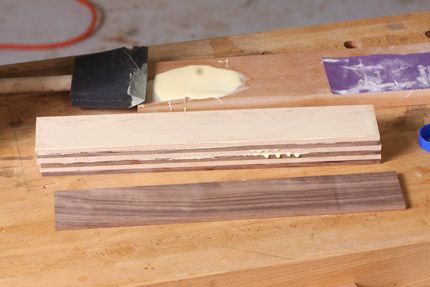
2) Alternating wood species form the basis of the pattern. I began by gluing up alternating strips of walnut and maple.
For me, perhaps the most intriguing aspect of federal furniture is the lyrical banding and stringing that often adorns drawer fronts, aprons, and legs. While we’ve covered stringing before at FineWoodworking.com, bandings haven’t received too much attention. With that in mind, I figured I’d head into the shop and craft some barber pole banding. The process is relatively straight-forward and if you’d like to see more on this subject-with a bona-fide expert like Steve Latta-let us know in the comments section below.

More Inlay Ideas |
How to Make Barber Pole Banding
I begin by milling up some 1/4-in. thick strips of walnut and maple, and then glued them up in a block, alternating the woods. Next, I built a simple crosscut sled for my bandsaw which could be used to slice off thin sections of the block at a 45-degree angle. The sled is nothing more than a 1/2-in. MDF base, a hardwood fence and a quartersawn oak runner that fits into the bandsaw table’s miter gauge slot.
Crosscutting the pieces at the bandsaw leaves a bit of “fuzz” on the workpieces. To clean them up a bit, I glued down some 220-grit sandpaper onto a piece of flat glass and sanded each piece somewhat smooth. I was careful to make the number of passes over the sandpaper consistent from piece to piece. Maintaining a consistent thickness among these workpieces is important.
Next, I glued a long string of my walnut/maple workpieces down to an 1/8-in. thick piece of maple and clamped the sandwich together using some MDF cauls. Once the glue was dry, I glued on another piece of 1/8-in. maple to complete the banding “sandwich.”
Once the packet was dry, I cleaned up the block and resawed my bandings at the bandsaw.
Let Us Know Your Thoughts
Remember, if you’re interested in learning federal-style banding techniques, please let us know in the comments section at the bottom of this blog post.
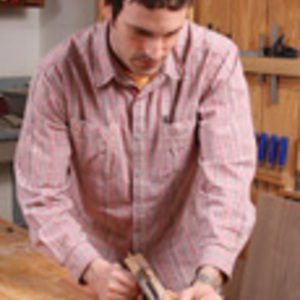
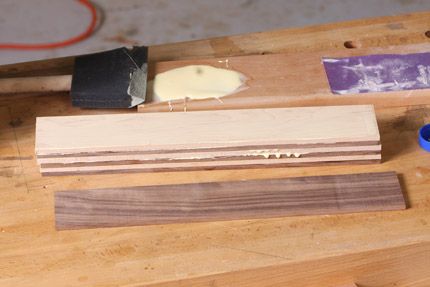
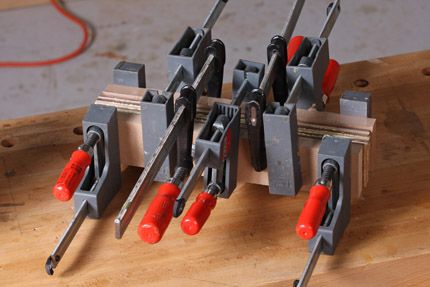

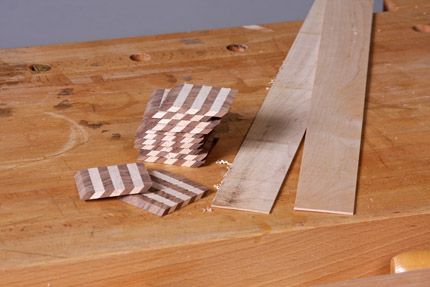
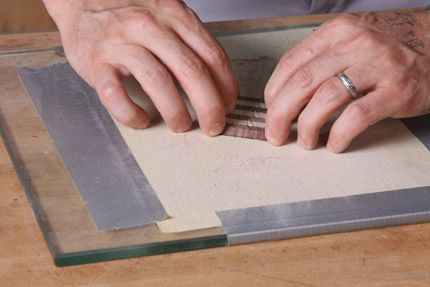

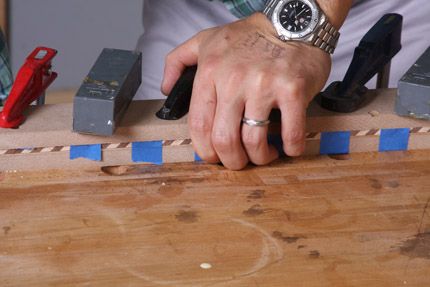

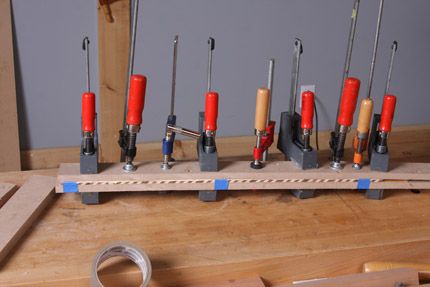
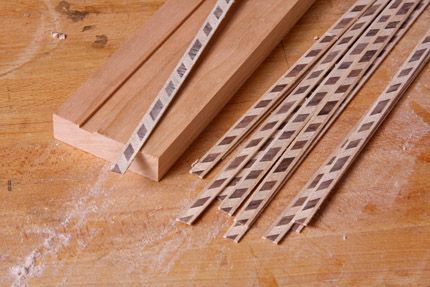
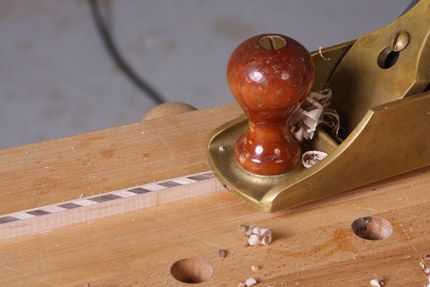






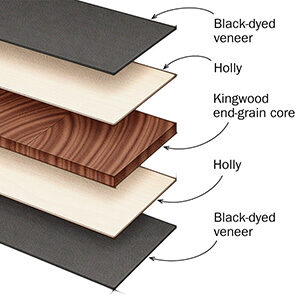













Comments
I always enjoy and vale the Federal Period content from FWW and Federal Period banding would be a welcomed addition. It would be interesting to not only cover the techniques, but to cover how it was done 150 years ago and what specific banding is correct/best for specific pieces.
Thumbs up on the magazine, the web site and the podcast!
Being new to the woodworking world, and trying to learn techniques on my own, I would be very open to learning more about the Federal Period banding.
Count me as another yes to learning the Federal Period banding techniques.
Yes, I would be interested not only in how to make your own, but also some trusted sources for purchased banding as well.
Cheers
Yes, please let Latta write more on banding!
Yes, more on banding by Steve Latta. I've read his articles, seen him speak and demonstrate, and watched the videos. He's an excellent teacher. Bring on more.
Would love to see more on banding. Also articles on hot sand shading techniques, bluebells, etc. as are seen on those beautiful federal pieces. Thanks!
Be sure to start and end the "sandwich" with different species of wood! Otherwise, you will end up with a 'double-wide' band when re-gluing the pieces together into the long strip (as seen in the above photos)
I have a collection of banding that I would like to find some use for as well as some guidance on best techniques. Also very interested in making my own banding and have saved all the articles I read on the subject. Video instruction though is best I find.
I too would love to see more written on banding techniques and stringing if possible. I'd also agree with Mike Davison in asking for advice on which projects are best accompanied with each addition.
If at all possible, I'd prefer video's. Thank you so much!
would enjoy more - especially some notes on techniques of the period.
Yes - would love to see more of Steve Latta's teaching on banding or any other federal style techniques. Thank you!
Yes, teach us more. This is great stuff to try out on a slow day, when I have one.
Defenitely count me in to learn more about Federal Period Banding.
Have tried it before with no success. Help Steve. Thanks.
I have taken Steve Latta's class at the Marc Adams School of Woodworking and learned more in the two days I was there than in a month of research online.
I have used the techniques I learned on many projects and have expanded from there.
He is an incredible teacher and someone who is not only knowledgeable, but passionate about Federal Period Furniture.
Keep his articles coming!!!!
-Nick-
Yes Bob, I have seen your website in the past. In fact, I had been considering putting together a mashup of a variety of different methods for producing several different bandings from across the web.
However I do not appreciate the comment you've left here. In fact, that is putting it mildly. To echo your own comment: Libel is the act of defamation taking form in printed text. I do not appreciate having those sorts of statements leveled against me. Ever. Period.
That little crosscut sled for the bandsaw is one that I've had for quite some time. It is the most efficient way to cut banding material due to the narrow kerf size. That's why it's commonly used. Not just by yourself. Barber pole banding is not an uncommon variant of banding but rather, a pretty common one.
I will not allow anyone to defame me, other contributors to our blogs, or other folks leaving comments. Therefore, I am taking the offensive comments down.
However, I do feel there is valuable information for folks interested in banding on your site and I think folks should check it out. I'm leaving a link below.
In summation: while it is unfortunate that you felt the fact that our two methods being spot on similar was some sort of plagiarism, it does not grant you the right to make wild accusations. Again, I will not accept that when foisted upon myself, our anyone leaving comments in a blog post on this site.
That said - Bob's site has some pretty cool stuff on it and you can find it here: theapprenticeandthejourneyman.com/
Regards,
-Ed
Yes, I too would love to see more of Steve Latta's teaching on banding or any other federal style techniques. It would be great to have some spare time to try the techniques. Thank you!
Three pluses: Federal Style, Steve Latta, and shop-made banding. Creating a video to go with it it would be even better!
John
Ed,
Thanks for your quick response. However, I think you are side stepping and minimizing a key point in your response.
"That little crosscut sled for the bandsaw is one that I've had for quite some time. It is the most efficient way to cut banding material due to the narrow kerf size. That's why it's commonly used. Not just by yourself. Barber pole banding is not an uncommon variant of banding but rather, a pretty common one."
1.) I would be willing to bet my 40 years of woodworking experience that you or other woodworkers did not use a band saw crosscut sled or the band saw specifically for the purpose of creating wood inlay bandings until after the publication dates of my blog and/or my woodworking videos.
2.) Yes, as I have previously pointed out in my tutorials, using a band saw with the cross cut sled is the most efficient way way to cut banding material due to the narrow kerf size. The band saw along with the band saw crosscut sled method is very accurate. This technique that I have developed is also much safer to use than previous common methods that involved the use of a table saw.
3.)"That's why it's commonly used." Be honest Ed. How many woodworkers have you seen use the band saw and the band saw sled method prior to the publication dates of my articles and videos on the subject of making wood inlay banding? In truth the answer is zero.
4.) Yes Ed, you're right. "Barber pole banding is not an uncommon variant of banding but rather, a pretty common one." I could not agree with you more.
I think it is great that you have an interest in wood inlay banding and want to do a mashup of the various methods. It appears we have a common interest in this wonderful facet of woodworking. More woodworkers should know about it.
As you well know from visiting my site I have invested considerable thought, time, and energy in regards to creating wood inlay banding. The same can be said for the special band saw sleds that I created for the variety of banding designs.
My intention from day one was to make an original contribution to the woodworking community. That is what I have done. As a result, many woodworkers like what I have produced and have shared freely with them.
Ed, here is the part where I lay my saber down. I invite you to do the same.
You have produced some excellent woodworking content as well Ed. I give you credit.
Keep up the good work,
Bob
MDcustom: NICE EYES! Yeah, I realized the "sandwich error" once I began gluing up the sequences. But then I felt: "heck, it's still a repeating pattern, l'll keep it."
Funny enough, I spoke about this on the podcast we're releasing this Friday. It was featured in one of our regular segments on Shop Talk Live. Again NICE CATCH! I was wondering how long it would take for someone to notice:)
Cheers,
E
I LOVE ARTICLES LIKE THIS. I HAVE MADE SOME BANDINGS AND LIKE ALL THE IDEAS I CAN GET
Ed,
shouldn't the pieces end with alternating woods so that when you put them end-to-end it is still contrasting?
also do you plan-ahead for corners that wrap around, so that the wraps do not end up being odd sizes?
BTW -- I would really enjoy more Steve Lata... I am planning to do his table(Im using cherry vs walnut)
I have read and studied just about everything I can find from Steve Latta so anything else he can put in your magazine. He also has some great videos over to Lie-Nielson that I highly recommend (I bought all of them!).
I know this is an old post but thumbs up for anything from Latta.
Log in or create an account to post a comment.
Sign up Log in